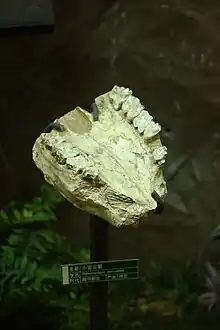Palaeotragus
Palaeotragus ("ancient goat") is a genus of very large, primitive, okapi-like giraffids from the Miocene of Africa and Eurasia.
| Palaeotragus Temporal range: | |
|---|---|
 | |
| Skeletal mount, Tianjin Natural History Museum | |
| Scientific classification | |
| Domain: | Eukaryota |
| Kingdom: | Animalia |
| Phylum: | Chordata |
| Class: | Mammalia |
| Order: | Artiodactyla |
| Family: | Giraffidae |
| Genus: | †Palaeotragus [1] |
| Type species | |
| †Palaeotragus rouenii Gaudry, 1861 | |
| Species | |
| |
Palaeotragus primaevus is the older species, being found in early to mid-Miocene strata, while P. germaini is found in Late Miocene strata. P. primaevus is distinguished from P. germaini by the lack of ossicones. It was also the smaller species, being a little under 2 m (6 ft 7 in) at the shoulders. P. germaini had a pair of ossicones, and in life, it would have resembled either a short-necked, 3 m (9.8 ft) tall giraffe, or a gargantuan okapi.
Species

P. microdon fossil
The genus consists of the following species:
- Palaeotragus decipiens
- Palaeotragus germaini
- Palaeotragus microdon
- Palaeotragus primaevus
- Palaeotragus quadricornis
- Palaeotragus. rouenii
References
Further reading
- Gaudry, Albert (1861). "Paléontologie. — Résultats des fouilles entreprises en Grèce sous les auspices de l'Académie". Comptes-rendus de l'Académie des Sciences. Vol. 53. Paris. p. 239. OCLC 469002103.
{{cite book}}: CS1 maint: location missing publisher (link)
This article is issued from Wikipedia. The text is licensed under Creative Commons - Attribution - Sharealike. Additional terms may apply for the media files.